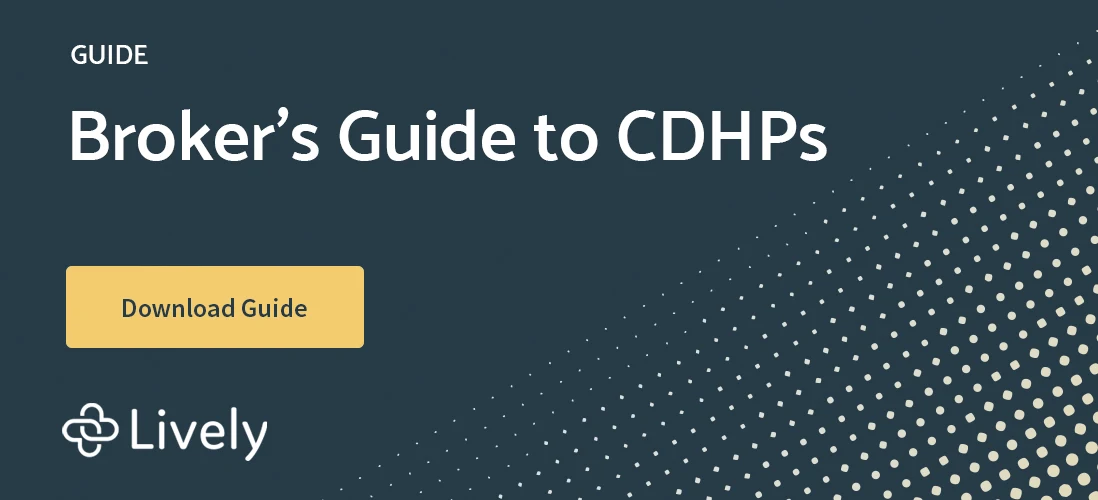The Lively Blog
SIGN UP FOR OUR
Newsletter
Stay up to date on the latest news delivered straight to your inbox
How Do Consumer-Driven Health Plans Benefit Clients?
Renee Sazci · December 7, 2020 · 7 min read

The client you’re approaching might be a long-standing member of your book of business. Or they could be a newcomer. If a CDHP isn’t in their benefits mix yet, maybe they haven’t had the correct combination of positioning and education to drive their adoption? This year, you’ll be prepared to show, not tell, how CDHPs stack-up against traditional health plans, among other benefits.
How do CDHPs benefit employers?
1. Saving on premium contributions
With a CDHP, your clients can cut costs in three ways. First, by saving on rising health insurance premium costs. The average family premium has increased a staggering 55% since 2010 and 22% since 2015. In 2020, the average annual premiums were $7,470 for single coverage and $21,342 for family coverage. And both single and family coverage premiums increased by 4% between 2019 and 2020. Clients who choose a CDHP can benefit from lower premium costs per employee.
Employers pay a larger part of premium costs than employees. And when evaluating their health plan mix, the cost is a majority decision-maker. That is especially true today. With the national health crisis and economic slowdown, more employers are evaluating and adopting CDHPs. Here’s why.
Offering employees a qualifying HDHP with lower premiums and higher deductibles represents an average of $720 less per employee (individual plan), per year, compared to a typical PPO plan. If your client has 100 employees, that’s a savings of $72,000 per year. If they have 500 employees, an HDHP can save their business $360,000 per year. That’s significant savings!
Average annual employer premium contributions: Single coverage by plan type

Average annual employer premium contributions: Family coverage by plan type

2. Save on FICA and FUTA taxes
The HDHP’s premium savings win over your clients, but the savings don’t stop there. Employers who offer a CDHP also reap the benefit of 7.65% FICA and FUTA tax savings. Both employer and employee HSA, FSA and HRA contributions made from payroll are FICA and FUTA tax exempt. Just one more way to save your clients money.
According to Devenir’s 2019 Year-End HSA Market Statistics & Trends report, the average employee HSA contribution was $169 per month or $2,034 annually in 2019. If a $169 per month HSA contribution is made for 100 employees, that could save your client $12,000 in taxes per year.
To determine how large your client’s savings could be, Lively created a Payroll Tax Calculator. Provide some basics about your client’s company—or share the link to this tool—and you’ll discover the expected tax savings.
Discover how much your clients could be saving.
3. Reduced medical costs
A third way that your clients can save money is in reduced medical costs. Employees on a CDHP share out-of-pocket costs, which helps them understand the costs of healthcare. That encourages them to make more informed decisions and empowers employees to be more proactive and cost-conscious with their healthcare decisions.
Here are some ways that employees enrolled in a CDHP reduce their healthcare costs, saving your client money:
Check if the plan will cover care.
Inform their doctor that they have an HDHP and discuss various treatment options and their related costs.
Request the generic drug instead of a brand name.
Develop a budget to manage health care expenses.
Use an online deductible-tracking tool, like Lively’s Deductible Tracker.
Keep receipts and track expenses for reimbursements from their HSA, FSA or HRA.
4. Attract and retain top talent
Because of the economic slowdown, some employers are reducing or canceling 401(k) contributions. One area they are not skimping on is HSA contributions. With the national health crisis, your clients know this is a benefit that provides security and high-value. In 2019, 39% of employers provided an employer contribution to an HSA.
HSA benefit growth could mean that more employees are looking for employer HSA contributions as part of their process in evaluating job opportunities. Similar to the value placed on 401(k) contributions. And employers are listening.
Health Savings Accounts and contributions offered

5. Increased employee satisfaction
Employees that have low healthcare utilization don’t want to overpay on premiums. They want choices. Offering a CDHP is part of a balanced health plan mix and provides options for cost-conscious employees. It’s also one of the ways that your clients can improve employee satisfaction.
Breaking down CDHPs for employers
A CDHP can offer cost savings in three primary ways:
Offering employees a qualifying HDHP with lower premiums and higher deductibles represents an average of $720 less per employee (individual plan), per year, compared to a typical PPO plan.
Both employer and employee HSA, FSA and HRA contributions made from payroll are FICA and FUTA tax exempt. That’s a payroll tax savings of 7.65%.
Clients can save money on their share of medical costs. Employees enrolled in a CDHP reduce their healthcare costs, in turn, reducing an employers’.
CDHPs attract talent and increase employee retention & satisfaction:
HSA benefit growth means that more employees are looking for employer HSA contributions as part of their process in evaluating job opportunities, similar to the value placed on 401(k) contributions.
Offering a CDHP is part of a balanced health plan mix. For cost-conscious employees or those with low healthcare utilization, this means more money in each paycheck—leading to increased employee satisfaction.
How do CDHPs benefit employees?

There’s no doubt that there are numerous reasons for employers to offer a CDHP. But the benefits extend to employees as well. And how these benefits are positioned will increase your client’s CDHP adoption and engagement success.
Here are some ways that CDHPs are winning big:
Enrolling in an HDHP may lower the employee’s monthly premium.
With an HDHP + HSA, FSA, or HRA, employees can pay for their deductible and qualified medical expenses with pre-tax money.
If the employee doesn’t need many healthcare items or services, they may benefit from the HDHP’s lower monthly premium. And if they need more care, they’ll save by using tax-free money from their HSA, FSA, or HRA.
The HSA balance rolls over year-to-year, allowing employees to build up a health safety net for products or services they need later.
Compared to FSAs and HRAs, HDHP + HSAs have the following unique attributes that make them more flexible for short-term medical needs or retirement healthcare savings.
An HSA offers triple tax savings: pre-tax or tax-deductible contributions, tax-free interest and investment earnings, and tax-free distributions for qualified medical expenses.
Anyone can contribute to an employee’s HSA.
The HSA account is fully portable between employers; the individual owns the account.
HSAs never expire. All unused amounts carry over year-to-year.
Interest may accrue depending upon the custodian and the type of deposit account.
Claims do not need adjudication.
Past HSA contributions can be used for out-of-pocket, qualified medical expenses, even if the employee isn’t currently enrolled in an HDHP.
Help employees determine if an HDHP plus an HSA or FSA is a better fit.
Consumer-Driven Health Plans offer your clients considerable savings. They can reduce the employer’s cost per employee with lower premiums, taxes and a reduced share of medical costs. They also help attract talent and increase employee retention and satisfaction, among other benefits. But none of these benefits can be realized without plan adoption.
Want to know how to communicate Consumer-Driven Health Plan options more effectively? Download the Broker’s Guide to CDHPs for HDHP + HSA/FSA/HRA definitions that will speed up the decision-making process and spur CDHP adoption amongst your clients.
Get started with Lively
If you are looking to add an HSA or FSA to your benefits offering to help your employees save on healthcare and your clients save on payroll taxes, reach out to us about partnering with Lively.

Benefits
2025 and 2026 Maximum HSA Contribution Limits
Lively · June 20, 2025 · 3 min read
On May 1, 2025, the IRS announced the HSA contribution limits for 2026: $4,400 for individual coverage and $8,750 for family coverage. That’s a $100–$200 increase from the 2025 limits, which are $4,300 and $8,550 respectively. If you’re 55 or older, you can still contribute an extra $1,000.

Benefits
What is the Difference Between a Flexible Spending Account and a Health Savings Account?
Lauren Hargrave · February 9, 2024 · 12 min read
A Health Savings Account (HSA) and Healthcare Flexible Spending Account (FSA) provide up to 30% savings on out-of-pocket healthcare expenses. That’s good news. Except you can’t contribute to an HSA and Healthcare FSA at the same time. So what if your employer offers both benefits? How do you choose which account type is best for you? Let’s explore the advantages of each to help you decide which wins in HSA vs FSA.

Health Savings Accounts
Ways Health Savings Account Matching Benefits Employers
Lauren Hargrave · October 13, 2023 · 7 min read
Employers need employees to adopt and engage with their benefits and one way to encourage employees to adopt and contribute to (i.e. engage with) an HSA, is for employers to match employees’ contributions.
SIGN UP FOR OUR
Newsletter
Stay up to date on the latest news delivered straight to your inbox

